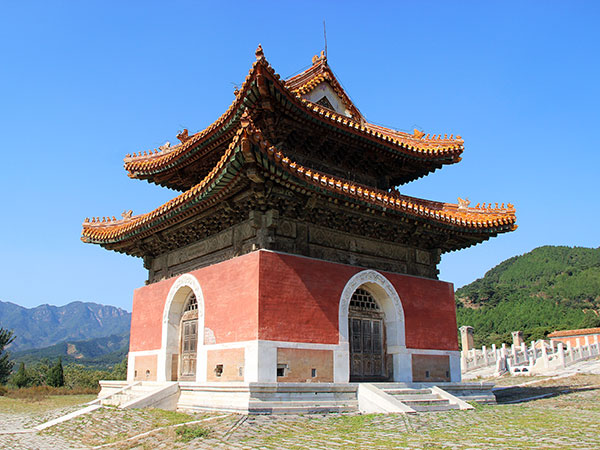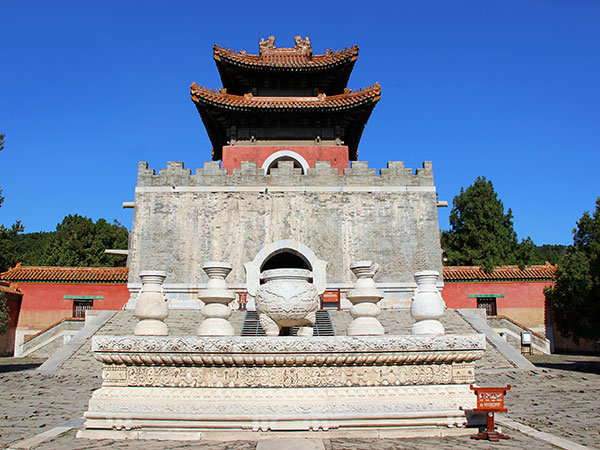Western Qing Tombs (also known as Western Royal Tombs of the Qing Dynasty near Beijing) is located in Yi County, Hebei Province, China, about 120 km from Beijing City. It is the burial place of four emperors of the Qing Dynasty (Yongzheng, Jiaqing, Daoguang and Guangxu Emperors) and their empresses, imperial concubines, princes and princesses, as well as other royal members. It is one of the largest, most complete and best protected existing mausoleum building complex of Qing Dynasty in China. The other imperial mausoleum building complex of the Qing dynasty is known as Eastern Qing Tombs, where is burial place of five emperors (Shunzhi, Kangxi, Qianlong, Xianfeng, and Tongzhi Emperors), 15 empresses, 136 imperial concubines, three princes, and two princesses of the Qing dynasty, and it is located in Zunhua, Tangshan City, Hebei Province, China, about 125 kilometers (78 miles) northeast of Beijing City.
Architectural style of the tombs reflects the feudal laws and institutions, and every mausoleum in the scenic strictly follows the rules of Qing Dynasty mausoleum construction. The buildings of tombs that are sheltered by yellow glazed tile roofs belong to be the emperors’ or empresses’ mausoleums, while the tombs buildings that are sheltered by green glazed tile roofs or grey tiled roofs belongs to be mausoleums of concubines, princesses, princes and other imperial members. The difference of the architecture shows different landscape and style. Western Qing Tombs covers an area of about 800 square kilometers, where houses more than one thousand x palace architectures, hundreds of ancient buildings and a lot of ancient sculptures. In 1961, Western Qing Tombs was included in the first batch of national key cultural relics protection units. In November, 2000, together with the Eastern Qing Tombs, it was Qingxiling together, was also recognized as a world cultural legacy by World Heritage Committee.
There is the largest ancient pine forest in the tombs area. From the beginning of the construction of the buildings, the emperors in Qing Dynasty ask their subjects to plant thousands of pines at the foot of Yongning Mountain. There are 15 thousand old pines, 200 thousand green pines and young cypresses, which make the mausoleums look luxuriant and green. pines cypresses trees are usually planted near to tombs in China, for they contains special moral of upright, noble, longevous and immortal. The 14 mausoleums are barely visible standing in the center of the pine forest.
Changling Tomb
History
Construction of the Western Qing tombs was started by the Yongzheng Emperor who broke with tradition and refused to be buried in the Eastern Qing Tombs. A folk legend goes, though is not proven: Yongzheng Emperor is afraid to be buried with his father(Kangxi Emperor) for his murder to his father and illegally usurped the throne by eliminating his own brothers. Then he chose a new place as emperor mausoleum. Therefore, Western Qing Tombs, built in 1730 AD (the 8th year of reign of Yongzheng Emperor), was an area used for tombs for Qing emperors after Yongzheng Emperor, and thereafter burials should alternate between the eastern and western sites, although which was not followed consistently. The first tomb, Tailing Tomb for Yongzheng Emperor, was completed in 1737, two years after the end of the Yongzheng reign. The last imperial tomb was in 1913, when the Guangxu Emperor was entombed in the Chongling Tomb.
Main Tombs to Visit in Western Qing Tombs Area
Western Qing Tombs includes four mausoleums (Tailing Tomb, Changling Tomb, Changling Tomb and Chongling Tomb) for imperial emperors, three mausoleums for queens, three mausoleums for concubines and four mausoleums for princes, princess and dukes. The imperial mausoleums includes: Tailing Tomb for Yongzheng Emperor, Changling Tomb for Jiaqing Emperor, Muling Tomb for Daoguang Emperor, Chongling Tomb for Guangxu Emperor. The Tailing Tomb for Yongzheng Emperor is the largest one among imperial tombs. Taidong Tomb for Xiaosheng Empress is the largest in Empress Tombs.
【Tailing Tomb】
As the largest one among imperial tombs, Tailing Tomb belongs to the main Tomb in Western Qing Tombs Area. It was constructed between 1730 and 1736. Tailing Tomb is the mausoleum of Yongzheng Emperor (1678–1735, the 3rd emperor of Qing Dynasty). As the earliest tomb of the Western Qing Tombs, it is where Yongzheng Emperor, Xiaojingxian Empress, and Dunsu Imperial Consort rest in peace. The Tailing Tomb locates in the middle of the scenic; other tombs are along the two sides.
The whole tomb is divided into two sections. The front section includes doors, arches, steles and pavilions, and the back section mainly includes palaces and underground palaces. It is the most appropriate place to take fine pictures of the grand buildings.
The sacred way, which guides visitors to the tomb, is paved with three layers of huge bricks, and the pines and cypresses, as well as 40 buildings in different sizes are distributed along the two sides from south to north. The first building displayed in the front is a five-arch-bridge, and three huge stone arches standing majestically. The architecture style of the stone arches looks majestic, with vivid inscribed pictures of mountains, rivers, flowers, grass, animals and so on. The stone arches are regarded as ones of the representative architectural art works among the buildings in Western Qing Tombs area.
Tailing Tomb
Changxiling Tomb, where is the burial place for Jiaqing Empress, is located in the west of Tailing Tomb. The famous Whispering Gallery is sited here. One people speak softly at the one end of the wall, the other people can hear clearly in the other end, very magic and funny. You may have a try when you get there.
【Changling Tomb】
Sited 2 kilometers west of the Tai Tombs, Chang Tombs are for Jiaqing emperor (1760–1820, the 5th emperor of Qing Dynasty) and Xiaoshurui Queen. There is a sacred way connecting the Tai Tombs with Changling Tomb. And it’s the only one that connects with the main tomb.
【Muling Tomb】
Sited in the west end of Western Qing Tombs Area, Muling Tomb is the burial site of Daoguang Emperor (1782–1850, the 6th emperor of Qing Dynasty). It is about 5 kilometers away from Tailing Tomb. The characteristic is its small scale, no stone arch, no soul tower, no stone statues and so on. But it is luxuriously and delicately decorated inside the main hall buildings. The great hall is made of Gold Phoebe, without any paint, keeping its natural color. You will smell the aroma of the Gold Phoebe when you enter the hall. There are graved dragons in every little grid of the ceiling.
Whispering Gallery
【Chongling Tomb】
Chongling Tomb is located in the west end of Western Qing Tombs Area, where is burial site for Guangxu Emperor (1871–1908, the 9th emperor of Qing Dynasty). The underground palace Chongling Tomb was once stolen, and it is now open for visitors. It is the only underground palace open to tourists in Western Qing Tombs. You can see the coffins of Emperor Guangxu and Longyu Empress Chun. Sculptures on the stone walls in the underground palace is also very beautiful and worth a visit.
Except for the above mentioned main tombs, there are other tombs for princesses, princes and other imperial member to visit. A Tibetan Buddhism temple called Yongfu Temple is worth a visit too.
The distance between different tombs is a little long. The Chongling Tomb at the east side is about 12 kilometers away from the Muling Tomb at the west side. Therefore, renting a car or Self-drive is the best way to travel around this place. There are also shuttle buses available to take tourists to different scenic areas, but they are operated by private operators, the price is not fixed and you’d better discuss and make it clear when you hop on one. The most recommended route to visit would be: visit firstly to Tailin Tomb, then walk to visit Changxiling Tomb, after that, continue your trip to Muling Tomb by car, and finally visit to Yongfu Temple and Chongling Tomb by car.
How to get to Western Qing Tombs
It is harder to reach because of the long distance from Beijing or other main cities, but once there they are usually deserted, quiet, soulful and beautiful. You won’t be disappointed. You’d better hired a car with driver (and a tour guide if you do not know local language) to take you to visit the tomb area. It takes about 3 hours’ driving from Beijing downtown. It is faster if the traffic is kind. Then you may visit tombs in this area one by one. The other reason why you need to rent a car for the trip is that to get around is that it’s about 11 km from the first tomb to the last, so having a car to get around is necessary. It is recommended to spend 2 to 3 hours to travel this place.



